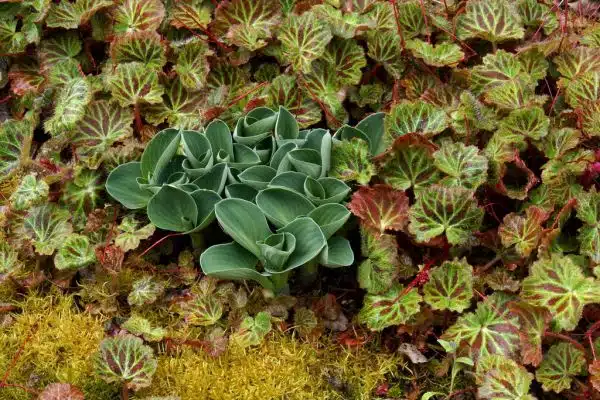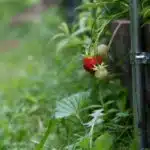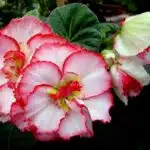Strawberry Begonia, scientifically known as Saxifraga stolonifera, is a small and delicate indoor plant belonging to the family Saxifragaceae. Its unique features including attractive green leaves with silver veins and tiny white flowers make it a popular choice among plant enthusiasts. The Strawberry Begonia has gained popularity for its low maintenance requirements and ability to thrive in various environments.
In this article, we will provide an in-depth guide on how to care for and grow the Strawberry Begonia indoors. We will explore the ideal growing conditions that promote healthy growth, soil requirements, watering schedules, pest control measures, propagation techniques, and other essential aspects of caring for this beautiful indoor plant. Whether you are a seasoned gardener or new to houseplants, this guide provides valuable insights into the world of indoor gardening and allows you to enjoy the beauty and benefits of the Strawberry Begonia.
Understanding The Saxifraga Stolonifera Plant Family
The Saxifraga stolonifera plant family is a group of herbaceous perennials that are native to East Asia, particularly in China and Japan. These plants are commonly known as the strawberry begonias because of their resemblance to the begonia family due to their attractive leaves. Despite this similarity, they belong to the saxifrage family, which is known for its succulent and fleshy leaves.
One unique characteristic of the Saxifraga stolonifera plant family is its ability to form runners or stolons. This feature allows the plant to propagate itself by producing new plants from the parent plant’s stem nodes. The strawberry begonias also have small white flowers that bloom during spring, adding more appeal to their already beautiful appearance.
Another interesting aspect of these indoor plants is that they have a high tolerance for low-light conditions, making them ideal for growing indoors. They require minimal care and maintenance and can thrive in a variety of soil types. With proper care and attention, these plants can live up to five years or more, providing long-lasting beauty and benefits to your home environment.
As we delve deeper into understanding the Saxifraga stolonifera plant family, it becomes apparent why indoor gardeners have grown fond of strawberry begonias over time. Not only do they add a touch of elegance and beauty to any room, but they also bring numerous benefits when grown indoors. Let us explore some of these benefits in detail in the next section.
Benefits Of Growing Strawberry Begonias Indoors
Strawberry begonias are a fantastic choice for indoor gardening enthusiasts. Not only do they add a touch of natural beauty to your home, but they also offer numerous benefits. One of the most significant benefits is their ability to purify the air we breathe. Strawberry begonias have been shown to absorb pollutants and toxins from the environment, leading to cleaner and healthier air inside your home.
Another advantage of growing strawberry begonias indoors is their adaptability. These plants can thrive in various lighting conditions, from bright direct sunlight to low light levels. However, it’s essential to provide them with moderate humidity levels and well-draining soil for optimal growth. With little maintenance, you can enjoy the beauty and health benefits that these plants bring into your home.
Lastly, strawberry begonias are a great choice for those who want to start their indoor garden but are limited on space. They’re small enough to fit in tight spaces like windowsills or bookshelves while still providing a stunning display of petals and foliage. Plus, they’re relatively easy to propagate and share with friends or family members who share your love for indoor gardening.
With just a few growth tips and some patience, anyone can successfully grow strawberry begonias indoors. In the next section, we’ll discuss how choosing the right location for your plant can make all the difference in its growth and well-being.
Choosing The Right Location For Your Plant
Did you know that the strawberry begonia is native to Brazil and grows in the humid tropical forests of South America? This plant prefers high humidity levels and indirect sunlight, making it an ideal indoor plant. When choosing the best location for your strawberry begonia, keep these preferences in mind.
To ensure healthy growth, avoid placing your strawberry begonia in direct sunlight. While this plant can tolerate some bright light, too much direct sun can cause its leaves to scorch and dry out. Instead, choose a spot with bright, filtered light or partial shade. A north-facing window or an east-facing window with a sheer curtain can provide just the right amount of light without harming your plant.
Take a look at this table for more information on the best locations for your strawberry begonia:
| Best Location | Light | Temperature |
|---|---|---|
| North-facing window | Bright, filtered light | 60-75°F (15-23°C) |
| East-facing window with sheer curtain | Partial shade | 60-75°F (15-23°C) |
| Room with bright, indirect light | Indirect sunlight | 60-75°F (15-23°C) |
In summary, choosing the right location for your strawberry begonia is crucial to its overall health and well-being. Avoiding direct sunlight and opting for bright, filtered light or partial shade will provide the ideal conditions for healthy growth. In the next section, we’ll discuss ideal growing conditions to maximize your plant’s potential.
Ideal Growing Conditions For Healthy Growth
After choosing the right location for your strawberry begonia, it’s important to understand the optimal growing conditions that will promote healthy growth. One of the most crucial factors to consider is temperature. Strawberry begonias thrive in temperatures ranging from 60-75°F (15-24°C). Be sure to avoid placing your plant in areas with extreme temperature fluctuations or near heating/cooling vents.
Another key factor in promoting healthy growth is providing adequate humidity. Strawberry begonias prefer a humid environment and will benefit from regular misting or placement near a humidifier. Aim for a humidity level of around 50-60% for optimal growth. However, be careful not to overdo it as excessive moisture can lead to fungal diseases.
Ensuring ideal growing conditions for your strawberry begonia can greatly increase its chances of thriving. By maintaining an optimal temperature and humidity level, you’ll create an environment that encourages healthy growth and minimizes stress on the plant. In the next section, we’ll explore soil requirements for strawberry begonias and how to ensure your plant has the best possible foundation for success.
Soil Requirements For Strawberry Begonias
The soil composition plays a significant role in the growth and development of the strawberry begonia plant. The ideal soil for this plant is well-draining, aerated, and slightly acidic. It should contain a mixture of organic matter and inorganic materials that provide essential nutrients to the roots.
When choosing a potting mix, it is crucial to consider its composition carefully. Garden soil should be avoided as it tends to become compact, hindering proper drainage and air circulation. Instead, it is recommended to use commercially available mixes that are specifically formulated for indoor plants. These mixes usually contain peat moss, vermiculite or perlite, and composted materials such as bark chips or coconut coir.
Another option is to create a custom mix by combining equal parts of peat moss, perlite/vermiculite, and sterilized garden soil. This mixture provides adequate drainage while retaining moisture levels suitable for the strawberry begonia plant’s growth. Whatever the chosen option may be, it is essential to ensure that the potting mix remains moist but not waterlogged.
The right soil composition guarantees healthy root development in strawberry begonias; however, it must also be appropriately cared for through regular watering schedules and techniques. Watering requirements will vary depending on various factors such as humidity levels, temperature, light exposure, pot size, and type of soil used. The next section will discuss watering schedules and techniques that are best suited for this beautiful indoor plant’s thriving growth.
Watering Schedules And Techniques
After having discussed the soil requirements for strawberry begonias, it is important to understand that proper watering schedules and techniques are essential for their growth. Watering is a vital aspect of plant care and plays a significant role in maintaining healthy foliage. Over-watering or under-watering can lead to detrimental effects on the growth of the plant.
Watering frequency should be determined by monitoring soil moisture levels. The soil must not be allowed to completely dry out but should never be soggy either. A well-draining potting mix combined with periodic deep watering can help maintain the required moisture levels. It is advisable to water strawberry begonias once every week during winters and twice a week during summers.
In addition to watering frequency, proper techniques must also be followed while watering. It is recommended to avoid overhead watering as it may cause damage to leaves and flowers. Instead, water directly into the soil, allowing it to reach the roots where it’s needed most. By following these simple steps, one can ensure healthy growth and vibrant foliage for their indoor strawberry begonia plants. Moving on, let us now discuss the light and temperature needs of these plants for optimal growth.
Light And Temperature Needs
Lighting tips are crucial for the strawberry begonia to thrive indoors. This plant needs a bright, indirect light to grow properly. It is best to place it near a north or east-facing window, where it can receive filtered sunlight. Direct sunlight can scorch the leaves and cause damage to the plant. If natural lighting is not sufficient, you can supplement it with artificial lighting using LED grow lights.
Temperature control is another important factor in caring for the strawberry begonia. This plant prefers temperatures between 60°F-75°F (15°C-24°C). It cannot tolerate sudden temperature drops or drafts, so keep it away from doors and windows that may feel chilly at night. Additionally, avoid placing the plant near heating vents or radiators as they can dry out the soil too quickly.
Proper lighting and temperature control will help your strawberry begonia thrive indoors. In the next section, we will discuss fertilizer and nutrient needs for this plant, which are equally important for its growth and health. By following these guidelines, you can ensure that your strawberry begonia stays healthy and beautiful year-round, providing a lovely addition to your indoor garden space.
Fertilizer And Nutrient Needs
Despite popular belief, the strawberry begonia is not actually a type of begonia. Instead, it belongs to the Saxifraga family and is commonly known as the Strawberry Geranium due to its resemblance to the fruit. As such, its nutrient needs are quite different from those of true begonias. Organic fertilizers can be a great way to provide nutrients for this plant, especially if you prefer an eco-friendly approach.
When it comes to organic fertilizers, options like fish emulsion or compost tea can provide a slow-release source of nutrients for your strawberry begonia. However, it’s important to note that over-fertilization can lead to nutrient deficiencies in these plants. Signs of over-fertilization include burnt leaf tips or edges and stunted growth. Therefore, it’s important to follow manufacturer instructions carefully and avoid over-fertilizing your plant.
Nutrient deficiencies are another issue that may arise when caring for your strawberry begonia. Common deficiencies include iron, magnesium, and nitrogen deficiencies which can result in yellowing leaves or poor growth. To prevent these issues from occurring, it’s important to regularly monitor your plant for any signs of deficiency and adjust your fertilizer accordingly. Additionally, providing adequate lighting and avoiding over-watering can also help prevent nutrient deficiencies in your strawberry begonia.
Moving on from fertilizers and nutrient needs, pruning and maintenance tips are also essential for keeping your strawberry begonia healthy and vibrant. By regularly pruning back any dead or damaged leaves or stems, you can promote new growth and ensure that your plant remains visually appealing. In addition, maintaining proper soil moisture levels and avoiding direct sunlight can help keep your plant looking its best year-round. Keep reading for more tips on how to care for this unique indoor plant!
Pruning And Maintenance Tips
Pruning techniques are necessary to maintain the health and aesthetic appeal of strawberry begonias. The plant can grow tall and leggy if not pruned regularly, resulting in a less attractive appearance. One technique is to pinch off the tips of the stems, which will encourage bushier growth. Another option is to remove any yellowing or dead leaves, as they can attract pests and disease.
In terms of maintenance schedule, it is recommended to prune strawberry begonias every few weeks during their growing season. This will ensure that the plant remains compact and healthy. It is also important to water the plant regularly, but not overwater it as this can cause root rot. Fertilizing once a month during active growth periods can also be beneficial.
Overall, proper pruning and maintenance can keep your strawberry begonia thriving for years to come. By following these techniques and schedules, you can enjoy a healthy and beautiful indoor plant that adds a touch of nature to your home decor. In the next section, we will discuss pest control measures that should be taken to prevent infestations from damaging your plant’s health and appearance.
Pest Control Measures
After maintaining and pruning your strawberry begonia, it’s important to take measures to control any pests that may affect the health of your plant. Pests such as spider mites, mealybugs, and aphids can quickly infest and damage your strawberry begonia if not addressed promptly. To prevent this from happening, you can implement a range of natural remedies and chemical treatments.
One effective natural remedy is neem oil, which is derived from the seeds of the neem tree. Neem oil acts as a natural insecticide by disrupting the feeding habits of pests and inhibiting their ability to reproduce. Another option is using diatomaceous earth, which is a fine powder made from fossilized algae. When sprinkled on the soil around your plant, diatomaceous earth will scratch and dehydrate any insects that come into contact with it.
If natural remedies are not enough to control the pest infestation, chemical treatments may be necessary. However, it’s important to exercise caution when using chemicals near indoor plants as they can be harmful if used incorrectly. Always follow the instructions provided by the manufacturer and wear protective clothing when applying any chemical treatment. Some effective options include pyrethrin-based sprays or insecticidal soap.
| Pest | Natural Remedies | Chemical Treatments |
|---|---|---|
| Spider Mites | Neem Oil, Diatomaceous Earth | Pyrethrin-Based Sprays |
| Mealybugs | Rubbing Alcohol Solution | Insecticidal Soap |
| Aphids | Essential Oils (Peppermint or Eucalyptus) | Horticultural Oil |
By taking measures to control pests in an efficient manner, you’ll be able to ensure that your strawberry begonia remains healthy and continues to thrive indoors. With proper care and attention to detail, your plant will bring beauty and joy to your home for years to come.
Transitioning into propagation techniques: from seeds to cuttings, it’s important to understand the methods and tools necessary for successful propagation.
Propagation Techniques: From Seeds To Cuttings
Strawberry begonia can be propagated through two main methods: seed germination and stem cuttings. Seed germination is a process that involves planting seeds in suitable soil conditions and providing them with adequate moisture and light. For strawberry begonia, the ideal temperature for germination ranges between 60-70°F. It takes around 2-3 weeks for the seeds to germinate, and once they do, it is important to transplant them into individual pots.
Stem cuttings are another popular propagation method for strawberry begonia. This technique involves taking a cutting from the mother plant, allowing it to callus for a few days, and then planting it in well-draining soil. It is essential to keep the soil moist during the rooting process until new growth appears. The best time of year to take stem cuttings is during spring or summer when the plant is actively growing.
Both seed germination and stem cuttings are effective propagation techniques for strawberry begonia. However, stem cuttings tend to produce quicker results as they are clones of the parent plant. On the other hand, seed germination can result in genetic variation within the offspring plants. Therefore, it ultimately depends on personal preference when deciding which method to use.
Transitioning into the subsequent section about ‘common problems and solutions’:
While propagating your strawberry begonia using either seed germination or stem cuttings can be an exciting process, it’s not always smooth sailing. Many common problems can arise during propagation that may affect your success rate. In this next section, we will discuss these issues in more detail and provide you with practical solutions for overcoming them.
Common Problems And Solutions
Now that you have successfully propagated your strawberry begonia, it is time to address any potential issues that may arise during the plant’s growth. Common problems such as yellow leaves, wilting stems, and pest infestations can quickly become a headache for any indoor gardener. However, with effective solutions and plant troubleshooting techniques at your disposal, these issues can be resolved quickly.
Yellow leaves are often a sign of overwatering or underwatering. To determine which one it is, check the soil moisture level and adjust accordingly. If the soil is too wet, allow it to dry out before watering again. Wilting stems may indicate root rot caused by overwatering or poor drainage. In this case, remove any affected parts of the plant and repot in fresh soil with better drainage.
Pest infestations can also occur with strawberry begonias. Mealybugs and spider mites are common culprits and can be treated with quick fixes such as insecticidal soap or neem oil spray. Regularly inspect your plant for signs of pests and take action immediately to prevent further damage.
| Problem | Cause | Solution |
|---|---|---|
| Yellow Leaves | Overwatering or Underwatering | Adjust watering habits |
| Wilting Stems | Root Rot from Overwatering or Poor Drainage | Remove affected parts & repot |
| Pest Infestations | Mealybugs & Spider Mites | Use insecticidal soap or neem oil spray |
Overall, maintaining a healthy strawberry begonia requires careful attention to its needs and prompt action when issues arise. By following these tips for common problems and solutions, you can ensure that your indoor garden thrives year-round. In the next section, we will discuss how to use your thriving plants to decorate your home with ease.
Decorating With Strawberry Begonias
Strawberry begonias can add a touch of color and texture to any living space. They are versatile plants that can be used in various DIY planters, including hanging baskets, terrariums, and traditional pots. When choosing a planter for your strawberry begonia, make sure it has proper drainage to prevent waterlogging.
To create an eye-catching display, try pairing your strawberry begonia with other indoor plants that have contrasting textures or colors. For example, mix in some succulents or ferns to create a dynamic arrangement. You could also choose a planter that complements the color of your strawberry begonia. Pairing pink or red begonias with blue or green planters can create a striking effect.
Incorporating strawberry begonias into your home decor can help promote a sense of calm and relaxation. The vibrant colors and soft foliage can have a soothing effect on the mind and body. Additionally, having plants in your living space has been linked to improved air quality and reduced stress levels. Try adding some strawberry begonias to your home today for both their aesthetic appeal and health benefits.
Transition: Incorporating plants into our daily lives can have numerous benefits beyond just aesthetics. In the following section, we will explore how using strawberry begonias for health and wellness can enhance our overall well-being.
Using Strawberry Begonias For Health And Wellness
Decorating with Strawberry Begonias can add a touch of elegance and charm to any room in your home. However, these beautiful plants are not merely decorative; they also have several health benefits that make them an excellent addition to any wellness routine. In this section, we will explore the various ways in which you can use Strawberry Begonias for your health and wellbeing.
One of the simplest ways to incorporate these plants into your wellness routine is by using them in smoothie recipes. Strawberries are known for their high antioxidant content, which can help protect against inflammation and chronic disease. When combined with other healthy ingredients like kale, spinach, and almond milk, Strawberry Begonias can give your smoothies an extra boost of nutrition and flavor.
Another way to enjoy the health benefits of Strawberry Begonias is through aromatherapy uses. The leaves of these plants have a sweet scent that can help relieve stress and anxiety when used in oils or diffusers. Simply add a few drops of essential oil to a diffuser or mix it with carrier oil for a relaxing massage blend that will leave you feeling calm and rejuvenated.
Using Strawberry Begonias for your health and wellbeing is just one more reason why these beautiful plants are such a great addition to any indoor space. So why not try incorporating them into your daily routine? With their lovely fragrance and numerous health benefits, they’re sure to become one of your favorite indoor plants in no time.
Conclusion: Enjoying The Beauty Of Strawberry Begonias Indoors
Strawberry begonias are not only beautiful indoor plants, but they also offer various health benefits. These plants help purify the air by removing toxins and increasing oxygen levels in the room. Additionally, they are easy to care for and do not require much watering or sunlight.
Decorating with strawberry begonias in your home can add a touch of elegance and color to any room. They are a great addition to bookshelves, windowsills, or as hanging plants. Their unique leaves and delicate flowers make them an eye-catching statement piece that can complement any decor style.
In conclusion, growing strawberry begonias indoors is a great way to bring beauty and health benefits into your home. With their low-maintenance care requirements and decorative appeal, these plants are a wonderful addition to any space. Consider incorporating them into your home decor for an added touch of natural elegance that will benefit both you and your environment.
Frequently Asked Questions
Can Strawberry Begonias Be Grown Outdoors?
The outdoor cultivation of strawberry begonias is possible, but it is crucial to consider the climate requirements of this plant. This type of begonia thrives in a warm and humid environment, making it more suitable for tropical or subtropical regions. However, it can also survive in cooler climates as long as it is grown in well-draining soil and sheltered from strong winds. Gardeners should also ensure that the plant receives enough sunlight without being exposed to direct heat, which can damage its delicate leaves. Overall, while growing strawberry begonias outdoors is feasible, it requires careful attention to climate conditions and proper care to ensure its healthy growth.
How Often Should Strawberry Begonias Be Repotted?
Repotting frequency is an important consideration for any indoor plant, and strawberry begonias are no exception. These plants generally require repotting once every one to two years, as their root systems can quickly outgrow their containers. When repotting, it is important to choose a well-draining soil mix that will provide adequate nutrients without becoming waterlogged. A mixture of peat moss, perlite, and sand can be a good option for strawberry begonias, as it allows for proper drainage while also retaining moisture. It is also important to ensure that the new container has adequate drainage holes to prevent water from pooling at the bottom. Overall, keeping an eye on the growth of your strawberry begonia and repotting when necessary can help ensure its health and longevity as a beautiful addition to your indoor space.
Are Strawberry Begonias Poisonous To Pets?
It is of utmost importance for pet owners to ensure the safety of their furry companions. One aspect that should be taken into consideration is the presence of toxic plants within the household. In particular, certain species of indoor plants are known to contain substances that can be harmful or even fatal to pets when ingested. Therefore, it is crucial for pet owners to be aware of the potential dangers posed by such plants and take necessary steps to mitigate any risks. While strawberry begonias may be aesthetically pleasing as indoor plants, it is important to note that they are considered toxic to pets and should be kept out of reach from curious animals.
Can Strawberry Begonias Be Used In Cooking Or For Medicinal Purposes?
Strawberry begonias, also known as Saxifraga stolonifera, have gained popularity not only for their ornamental value but also for their potential culinary applications and health benefits. In terms of cooking, the leaves and stems of this plant can be used fresh in salads or dried and ground into a powder to add flavor to various dishes. Moreover, strawberry begonias are believed to possess medicinal properties that could aid in treating ailments such as respiratory issues, digestive problems, and inflammation. However, further research is needed to confirm these claims. Overall, incorporating strawberry begonias into one’s diet or wellness routine may offer a unique twist on traditional ingredients and provide potential health benefits.
How Long Do Strawberry Begonias Typically Live?
The life expectancy of the strawberry begonia plant can vary depending on various factors such as environmental conditions, propagation methods, and care practices. Generally, the plant can live for several years if provided with optimal growing conditions. The strawberry begonia can be propagated through stem cuttings or division of mature plants. To extend the lifespan of the plant, it is crucial to avoid overwatering and ensure that the soil is well-draining. Proper fertilization and pruning can also promote healthy growth and longevity. With adequate care, the strawberry begonia can serve as an attractive indoor ornamental plant for several years.
Conclusion
Strawberry Begonias, also known as Saxifraga Stolonifera, are a popular choice for indoor plant enthusiasts. Although they are commonly grown indoors, they can also thrive outdoors in shaded areas with well-draining soil. However, it is important to monitor their growth and keep them out of direct sunlight to prevent leaf scorching.
These plants should be repotted every one to two years, depending on their size and growth rate. It is recommended to use a high-quality potting mix that is rich in organic matter and provides good drainage. While these plants may look tempting to pets, they are not harmful if ingested.
Contrary to their name, Strawberry Begonias are not related to strawberries and should not be consumed or used for medicinal purposes. With proper care and maintenance, these plants can live up to five years or more. So go ahead and add this charming little plant to your collection – just don’t expect any delicious fruit!
Image Credits
- “Strawberry Begonia” by jacki-dee (featured)





























